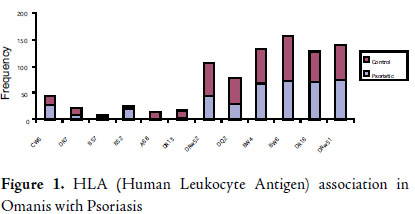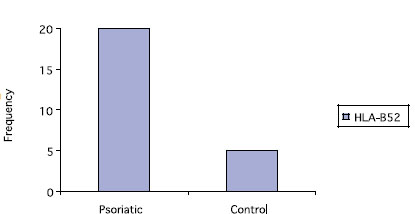HLA Antigens in Omani Psoriasis Vulgaris Patients
Fatma Al-Mamari, Ali Al-Shirawi, DD Banodkar, Suliman Al-Hashmi, Faiza Al-Yahyaae, Mathew Varghese, JA Raeburn
ABSTRACT
Objectives: To determine the frequency of different HLA-antigens in patients with plaque psoriasis in the Omani Arab population.Methods: Fifty four Omani patients clinically diagnosed with plaque psoriasis attending the dermatology outpatient clinic in Al-Nahdah Hospital (the tertiary dermatology centre in Oman) were selected for HLA studies.Results: HLA-B52 was present in 20.4% of patients 11/54 and in 5% of controls without psoriasis 5/100. For the association p was <0.004 and the relative risk (RR) was 4.86.Conclusion: Psoriasis does not appear to be associated universally with the same HLA antigens. The association of HLA-B52 with plaque psoriasis in Omani patients compares with the HLA-Cw6, -Bw57 and -DR7 preponderance in most other ethnic groups.
From the 1Department of Dermatology and Genito-Urinary Medicine, Al Nahdah Hospital Ruwi, Muscat, Sultanate of Oman; 2Department of Medicine (Rheumatology), Sultan Qaboos University Hospital, Al Khoud, Muscat, Sultanat e of Oman; 3Department of Genetics, College of Medicine and Health Sciences, Sultan Qaboos University, Al Khoud, Muscat, Sultanate of Oman.
Received: 20 Sep 2008
Accepted: 21 Nov 2008
Address correspondence and reprint request to: Dr. Fatma Al-Mamari, Department of Dermatology, Al Nahdah Hospital, P.O. Box 937, P.C. 112, Ruwi, Muscat Sultanate of Oman.
E-mail: fatmaalmamari@hotmail.co.uk
.
INTRODUCTION
Psoriasis is a common, chronic, non-contagious, inflammatory, dermatosis characterised by sharply demarcated erythematous papules and plaques with abundant silvery‑white scales. It is a genetically programmed disease of abnormal inflammation, which is triggered by environmental stimuli.1 The analysis of Human Leukocyte Antigen (HLA) haplotypes has provided evidence that susceptibility to psoriasis is associated with class I and II major histocompatibility loci of the HLA gene complex on human chromosome 6.2 HLA antigen frequencies have now been studied in many psoriatic populations and reported associations in different racial and ethnic groups include (A1, A2, B13, B17, Cw6 and DR7).3
At the last census (2003), the population of Oman was 2.34 million of which 1.78 were Omanis and the rest expatriates. The Omani population comprises mainly three ethnic groups, more than half being Arab, with the rest having ethnic Asian and African groups as well. The objective of this study was to determine the frequency of HLA antigens in Omanis of Arab origin with plaque psoriasis.
METHODS
HLA typing for class I (HLA- A, -B, and –C) and class II (HLA-DQ, and DR) was performed in 54 Omanis (Arab-origin) with plaque psoriasis type 1 (since all patients in this study developed psoriasis before the age of 40 years) and the antigen frequencies compared with 100 Omani (Arab-origin) controls who were blood donors or potential kidney or bone marrow donors. The ages of the patients ranged from 11-70 years, with mean age of 35.7 years. 21 patients were female representing (38.9%) of the cases, whereas 33 patients were males which constituted (61.1%) of the cases. Out of the total 54 cases, there was positive family history of psoriasis in 6 which constituted 11.1%.
For serological HLA typing for class I, 15-20 ml of blood taken into Ethylene Diamine Tetraacitic Acid (EDTA) was used. Lymphocytes were separated by density gradient centrifugation and HLA typing was performed using a modified two stage cytotoxicity technique with ethidium bromide/acridine orange staining and observation with a semi -automated fluorescent microscope.
For class II typing (DR & DQ), DNA was extracted from 1 ml of EDTA blood using a commercial kit (Puregene, USA). The separated Deoxyribonucleic Acid (DNA) was incubated in a thermal cycler, with Class II primers defining DRb and DQb alleles (Dynal low-resolution sequence-specific primers, Dynal, UK), together with Polymerase Chain Reaction (PCR) buffer (dynal mix plus), taq Polymerase (Promega) and DNA nucleotides. The products were run on 1.2% agarose gels containing ethidium bromide, examined under Ultraviolet (UV) illumination and the Class II specificities were determined.
The following specificities were determined (88 in total):
A locus: 1, 2, 3, 11, 23, 24, 26, 28, 30, 31, 32, 33, 34, 36, 68, 74;
B locus: 5, 7, 8, 13, 14, 15, 17, 18, 27, 35, 37, 38, 39, 40, 41, 42, 44, 45, 49, 50, 51, 52, 53, 55, 57, 58, 61, 62, 63 Bw4, Bw6;
C locus: w1, w2, w3, w4, w5, w6, w7, w8, w10, w12, w14, w15, w16, w17, w18;
DR locus: 1, 3, 4, 7, 8, 9, 10, 11, 12, 13, 14, 15, 16, 17, DRw51, DRw52 and
DRw53;
DQ locus: 1, 2, 3, 4, 5, 6, 7, 8, 52.
Statistical analysis used the Yates corrected chi-square test. The strength of the association was estimated by calculation of the relative risk (RR) [(antigen positive patients × antigen negative controls)/(antigen negative patients × antigen positive controls)].
RESULTS
The HLA results are summarised in Table I and Figures 1 and 2 and indicate some association of plaque psoriasis with particular Class I and II major histocompatibility antigens,1 there being statistically significant differences between patients and controls for B52, A68, DR13, DRw52 and DQ2. In particular, HLA-B52 was expressed in 20.4% of patients (11/54) and in 5% of controls (p<0.004, RR=4.86). Other antigens (Cw6, DRw51, and DR16) were apparently elevated in patients compared with controls, but the differences were not significant. A68 was more expressed in controls (14% compared to 1.9% in patients), as was DR13 (expressed in 14% controls versus 3.7% patients).

Figure 1. HLA (Human Leukocyte Antigen) association in Omanis with Psoriasis

Figure 2. HLA-B52 in psoriatics
Table 1. Antigens Associated with Plaque Psoriasis in Omanis
RR |
P Value |
Frequency Control group (%) |
Control group (n) |
Frequency Psoriatic group (%) |
Psoriatic group (n) |
Antigen
|
4.86 |
0.004 |
5 |
5 |
20.4 |
11 |
B52 |
0.12 |
0.011 |
14 |
14 |
1.9 |
1 |
A68 |
0.24 |
0.037 |
14 |
14 |
3.7 |
2 |
DR13 |
0.52 |
0.044 |
47 |
47 |
31.5 |
17 |
DQ2 |
0.49 |
0.027 |
62 |
62 |
44.4 |
24 |
DRw52 |
2.02 |
0.065 |
16 |
16 |
27.8 |
15 |
Cw6 |
0.58 |
0.226 |
15 |
15 |
9.3 |
5 |
DR7 |
1.40 |
0.470 |
4 |
4 |
5.6 |
3 |
B57 |
1.12 |
0.448 |
66 |
66 |
68.5 |
37 |
Bw4 |
0.59 |
0.134 |
83 |
83 |
74.1 |
40 |
Bw6 |
1.65 |
0.111 |
59 |
59 |
70.4 |
38 |
DR16 |
1.77 |
0.090 |
64 |
64 |
75.9 |
41 |
DRw51 |
DISCUSSION
HLA antigens have been studied in many psoriatic populations and significant associations are known (e.g. A1, A2, B13, B17, Cw6, DR7)3 in various racial and ethnic groups. The known associations include the class I HLA-Cw6 and the class II HLA-DR7 antigens4,5. Of these, the most consistently reported association with psoriasis and the largest relative risk have been shown for the HLA-Cw6 antigen,6,7 which seems to be associated with psoriasis in most ethnic groups.8 Approximately 55% to 80% of white populations with psoriasis express the HLA-Cw6 antigen, compared with only 20% of the general white population. The relative risks range between 4 and 156,7. Thus, HLA patterns in a study of 70 Finnish subjects with plaque psoriasis3, showed that HLA-Cw6 was the commonest HLA antigen to influence risk.
Cw6 was found in 27.8% of our patients (n=15/54) in contrast to 16% in controls (p<0.065, RR=2.02). With greater numbers we might see a statistically significant increase.
However we did not see an increase in DR7 in our patients (9.3% vs. 16% in controls. Also, B57 was reduced in our patient group and in Omani controls (5.6% and 4% respectively). We might speculate that HLA-A68, DR13, DRw52 and DQ2 may play a protective role in psoriasis, but much greater numbers form Omani or similar populations will be required to test this.
Although some diseases have a universal association, worldwide association with a particular HLA antigen (for example HLA B27 and ankylosing spondylitis), psoriasis is not associated universally with the same HLA antigens. This corresponds to the association of Bw6 and DR7 antigens with vitiligo in Omani patients instead of the DR4 antigen excess reported in other ethnic groups9 or the association of rheumatoid arthritis with DR3 in Arabs rather than DR4 or DR1, as reported in other ethnic groups10. HLA B52 was found to be associated with recurrent apthous stomatitis in Israeli Arab adolescents11 with Behcet’s syndrome, with patients12 with Takayasu’s arteritis (TA) in Asian ethnic groups13 and with ulcerative colitis in Japanese.14
It appears that psoriasis is associated with different HLA antigens in different racial and ethnic groups with a variable strength of association. These differences may reflect selective environmental influences as well as pure genetic mechanisms. This study is the first to be reported on Omani patients and the HLA findings are markedly different from other ethnic groups reported. These give clues to the further investigation of the aetiology of plaque psoriasis and to the immunological mechanisms which might be operating.
CONCLUSION
It appears that psoriasis is associated with different HLA antigens in different racial and ethnic groups with a variable strength of association. These differences may reflect selective environmental influences as well as pure genetic mechanisms. This study is the first to be reported on Omani patients and the HLA findings are markedly different from other ethnic groups reported. These give clues to the further investigation of the aetiology of plaque psoriasis and to the immunological mechanisms which might be operating.
ACKNOWLEDGMENTS
The authors appreciate the assistance of Fahed Al-Zidjali for assistance with the statistical analysis.
The authors report no conflict of interest and no funding has been received in this work.
-
Anthony A. Gaspari. Innate and adaptive immunity and the pathophysiology of psoriasis. J American Acad. Dermatol. 2006; 54:67-80.
-
Tilo Henseler. The genetics of psoriasis. J American Acad. Dermatol. 1997; 37: 1-11.
-
Ikäheimo I, Silvennoinen-Kassinen S, Karvonen J, Järvinen T, Tiilikainen A. Immunogenetic profile of psoriasis vulgaris: association with haplotypes A2, B13, Cw6, DR7, DQA1*0201 and A1, B17, Cw6, DR7, DQA1*0201. Arch Dermatol Res. 1996; 288:363–367.
-
Henseler T, Koch F, Westphal E. Presence of HLA- DR7 in type I psoriasis. J Invest Dermatol. 1992; 98:607.
-
Schmitt Egenolf M, Boehncke WH, Ständer M, Eiermann TH, Sterry W. Oligonucleotide typing reveals association of type I psoriasis with the HLA-DRB1*0701/2, -DQA1*0201, -DQB1*0303 extended haplotype. J Invest Dermatol. 1993; 100:749–752.
-
Henseler T, Christophers E. Psoriasis of early and late onset: characterization of two types of psoriasis vulgaris. J Am Acad Dermatol. 1985; 13:450–456.
-
Tiilikainen A, Lassus A, Karvonen J, Vartiainen P, Julin M. Psoriasis and HLA-Cw6. Br J Dermatol. 1980; 102:179–184.
-
Nakagawa H, Asahina A, Akazaki S, Tokunaga K, Matsuki K, Ishibashi Y, et al. Association of Cw11 in Japanese patients with psoriasis vulgaris. Tissue Antigens. 1990; 36:241–242.
-
Venkataram MN, White AG, Leeny WA, Al Suwaid AR, Daar AS. HLA antigens in Omani patients with vitiligo. J Clinical and Experimental Derm. 1995; 20:35-37.
-
Sattar MA, al-Saffar M, Guindi RT, Sugathan TN, White AG, Behbehani K. Histocompatibility antigens (A, B, C, and DR) in Arabs with rheumatoid arthritis. Disease Markers 1990; 8:11-15.
-
Jaber L, Weinberger A, Klein T, Yaniv I, Mukamel M. Close association of HLA-B52 and HLA-B44 antigens in Israeli Arab adolescents with recurrent aphthous stomatitis. Arch Otolaryngol Head Neck Surg. 2001; 127:184-187.
-
Arber N, Klein T, Meiner Z, E Pras, Weinberger A. Close association of HLA-B51 and B52 in Israeli patients with Behçet’s syndrome. Ann Rheum Dis1991; 50: 351-353.
-
Charoenwongse P, Kangwanshiratada O, Boonnam R, Hoomsindhu U. The association between the HLA antigens and Takayasu’s arteritis in Thai patients. International J of Cardiology. 1998; 66:117-120.
-
Seki SS, Sugimura K, Ota M, Matsuzawa J, Katsuyama Y, Ishizuka K, et al. Stratification analysis of MICA triplet repeat polymorphisms and HLA antigens associated with ulcerative colitis in Japanese. Tissue Antigens. 2001; 58:71-76.